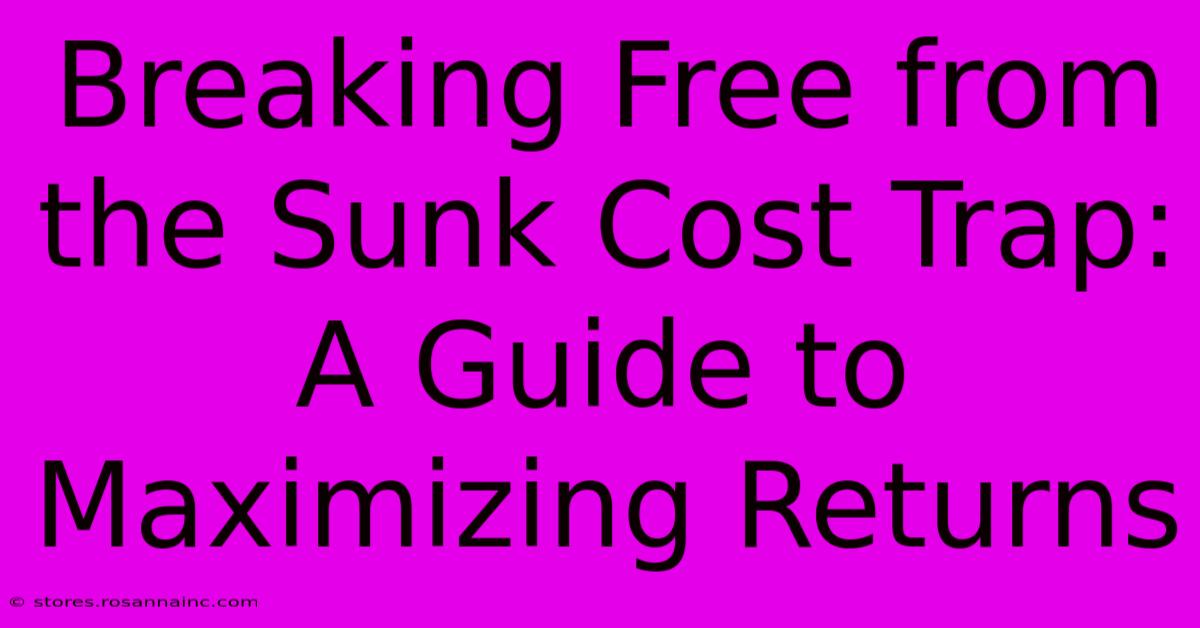Breaking Free From The Sunk Cost Trap: A Guide To Maximizing Returns

Table of Contents
Breaking Free from the Sunk Cost Trap: A Guide to Maximizing Returns
We've all been there. Stuck in a project, a relationship, or a career path that's clearly not working, yet we persist. Why? Because we've invested so much time, money, or effort already. This is the dreaded sunk cost fallacy, and it's robbing you of the opportunity to maximize your returns. This comprehensive guide will help you identify the sunk cost trap and learn strategies to break free.
Understanding the Sunk Cost Fallacy
The sunk cost fallacy is a cognitive bias that leads us to continue investing in something – be it time, money, or effort – simply because we've already invested in it, regardless of whether continued investment is worthwhile. Sunk costs are past expenses that cannot be recovered. They should be irrelevant to future decisions. Yet, our brains often cling to them, leading to poor choices.
Examples of the Sunk Cost Trap:
- Staying in a failing business: You've poured years and significant capital into a business that's consistently losing money. Rather than cutting your losses and moving on, you continue investing, hoping for a turnaround that's unlikely to happen.
- Finishing a bad movie: You're bored stiff watching a film, but you feel obligated to finish it because you've already paid for the ticket.
- Persisting in a toxic relationship: You stay in a relationship that brings you unhappiness because you've invested so much time and emotional energy.
Recognizing the Signs You're Caught in the Trap
Are you exhibiting these behaviors? If so, you might be trapped by sunk costs:
- Ignoring negative feedback: You dismiss criticism or evidence suggesting the investment is failing.
- Justifying continued investment: You create elaborate justifications for staying the course, ignoring the negative consequences.
- Focusing on past investment rather than future potential: You spend more time dwelling on what you've already put in than considering the potential outcomes of future investment.
- Fear of admitting failure: The thought of admitting defeat and wasted resources is paralyzing.
Strategies for Breaking Free
Escaping the sunk cost trap requires a conscious effort to shift your focus from the past to the future. Here are some powerful strategies:
1. Objectively Assess the Situation
Step back and analyze your investment dispassionately. Forget about what you've already invested. Focus solely on the potential future returns. Is it likely to yield positive results? If not, it's time to cut your losses.
2. Reframe Your Thinking
Instead of viewing sunk costs as a reason to continue, reframe them as a learning experience. What lessons have you learned from this investment? How can you apply those lessons to future endeavors?
3. Set Clear Exit Strategies
Before embarking on any significant investment, define clear criteria for when you'll exit. This could be a specific financial target, a timeline, or a set of performance indicators. Sticking to these criteria will prevent you from falling prey to the sunk cost fallacy.
4. Practice Mindfulness
Mindfulness helps you stay present and avoid getting caught up in past regrets. By focusing on the present moment, you can make more rational decisions about future investments.
5. Seek External Advice
Sometimes, an objective outsider can help you see the situation more clearly. Talking to a trusted friend, mentor, or professional can offer valuable perspective and help you break free from emotional biases.
Maximizing Future Returns: A Proactive Approach
Avoiding the sunk cost trap isn’t just about escaping bad situations; it's about proactively maximizing future returns. Here's how:
- Diversify your investments: Don't put all your eggs in one basket. Spreading your resources across different opportunities reduces the risk of significant losses.
- Regularly review your investments: Periodically assess the performance of your investments and make adjustments as needed. Don't be afraid to cut your losses or reallocate resources.
- Embrace calculated risks: While avoiding the sunk cost fallacy is crucial, don't let fear of failure paralyze you from taking calculated risks.
By understanding and applying these strategies, you can break free from the sunk cost trap and dramatically improve your chances of maximizing returns in all aspects of your life. Remember, letting go of past investments doesn't mean failure; it means making room for future success.

Thank you for visiting our website wich cover about Breaking Free From The Sunk Cost Trap: A Guide To Maximizing Returns. We hope the information provided has been useful to you. Feel free to contact us if you have any questions or need further assistance. See you next time and dont miss to bookmark.
Featured Posts
-
When Order Crumbles The Ethereal Hue Of Chaos
Feb 04, 2025
-
The Ultimate Collection New Years Cards That Celebrate The Magic Of 2023
Feb 04, 2025
-
The Ultimate Guide To Palm Delight Expert Tips For Thriving Indoor Palms
Feb 04, 2025
-
Pixel Magic How Sunday Citizen Enchants Your Digital Canvas
Feb 04, 2025
-
Unleash The Elegance Of Perry Homes In The Heart Of Austin
Feb 04, 2025
